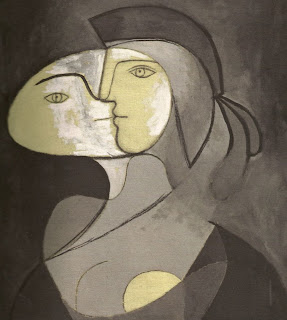Jan Gordon and Pablo Picasso
Last weekend we visited the Picasso Black and White
exhibition at the Museum of Fine Arts Houston. The range of styles on show was remarkable, from coolly classical to astonishingly abstract. "Head of a Man" 1908 looks like a Fang Ngil mask from Gabon. The several studies for
“Guernica” reminded me of a visit to that town in 1994 (studying the nearby geology), looking quiet and peaceful on a
sunny day and giving no hint of the Luftwaffe's horrific bombing in 1937.
Jan and Cora Gordon were contemporaries of Picasso in Paris and Jan Gordon wrote about him in “Modern French Painters” (1923 and later editions), a
volume dedicated to my grandparents.
He wrote, “Picasso – Pablo Ruiz is his real name – is the
most vivid and and the most dramatic personality which has come into the art of
today.”
“Picasso may well be considered as the problem of modern
art. He has bewildered the public by the variety of and the differences between
his artistic phases. An exhibition of haphazard Picassos, such as that held at
the Leicester galleries, looks like the work of a group of five or six men who
have scarcely an obvious idea between them. Monsieur Coquiot, the often subtly
malicious author of “Les Indépendants,” calls Picasso a chameleon and
the epithet seems not unearned.”
However, Jan Gordon continued, "Picasso, is a chameleon with some
internal-illuminant, he often reflects a borrowed colour more strongly than he
has received it.”
Marie-Thérèse, Face and Profile 1931
Jan Gordon reproduced two Picasso works in his book, "Three Nudes" and "The Red Cloth" (1922).
We walked out of the Houston exhibition of 118 works (made between 1904 and 1970) last Saturday with this same impression of Picasso as a chameleon, but also with a sense of wildly restless experimentation.
We walked out of the Houston exhibition of 118 works (made between 1904 and 1970) last Saturday with this same impression of Picasso as a chameleon, but also with a sense of wildly restless experimentation.




Comments
Post a Comment